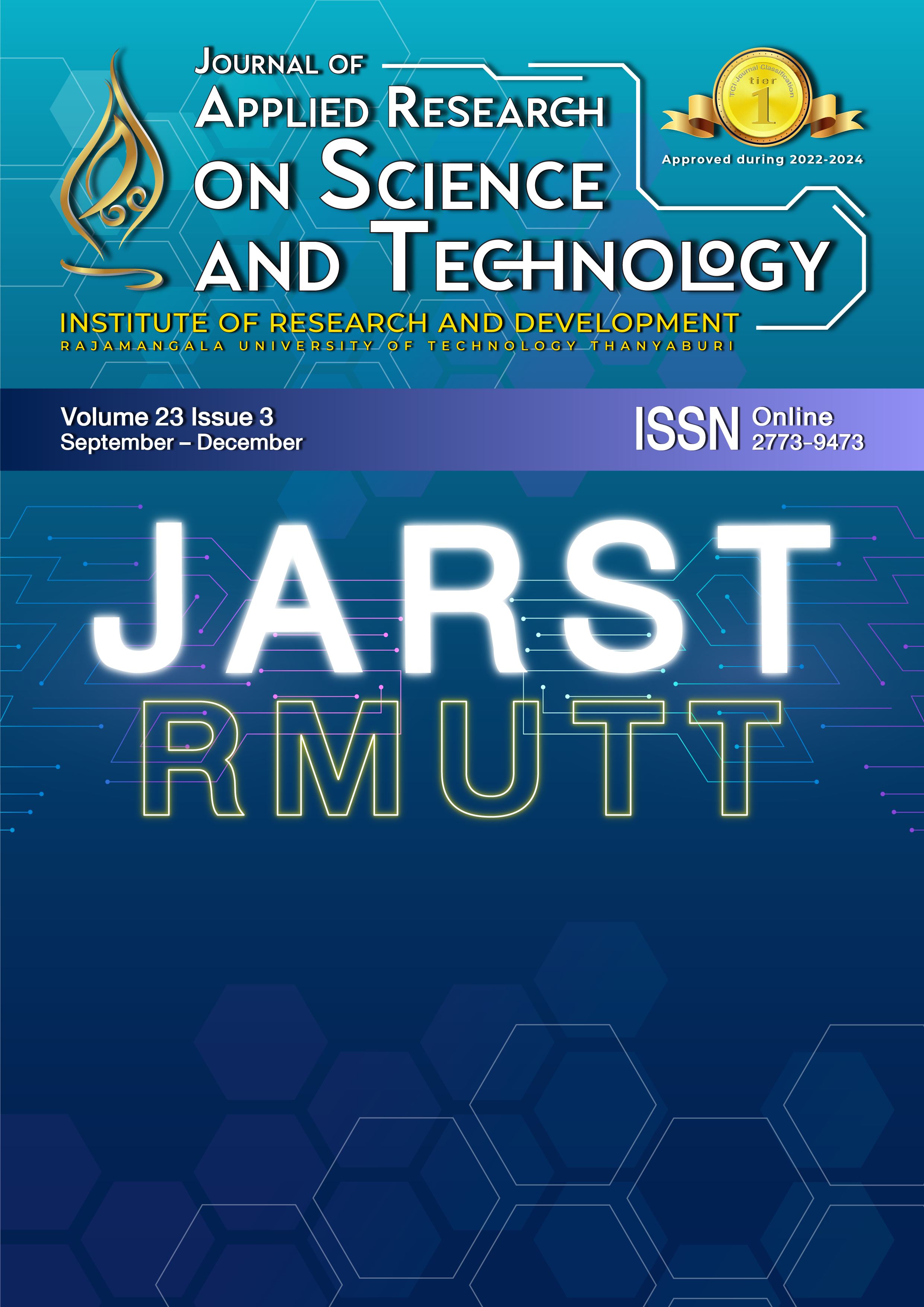The fabrication of wood alternative material from cassava rhizome and cassava peel pulp
Main Article Content
Abstract
The increasing demand for wood alternative material in construction and furniture. Corresponds to global efforts to reduce pressure on forests, necessitating the exploration of alternative materials to wood. The agricultural industry can not only supply raw materials from non-wood plants but also waste material and byproducts. The aim of this research was to explore and manufacture wood alternatives using cassava rhizomes and cassava peels, thereby valorizing agricultural waste. The research methodology involved blending milled rhizomes and cassava peels with urea-formaldehyde resin followed by a hot-pressing process to form the final product. The samples size for this study was 450x450x10 mm were made using 6-10 percent urea-formaldehyde resin by weight of the composite materials aiming to achieve a sheet density about 600 kg/cu-m. Three distinct ratios of Cassava rhizome to cassava peel pulp were examined as potential wood substitutes. All test results of sample were compared with the industrial standards outlined in Thai Industrial Standard. The study found that wood substitutes created from Cassava rhizome and Cassava peel pulp combined with urea-formaldehyde resin could meet the set standards. Cassava rhizome improves important properties like density, moisture content, thickness swelling, formaldehyde content, modulus of rupture, and modulus of elasticity according to TIS 876-2547 standards. However, adding peel pulp tends to reduce these qualities. There is no significant change in the density of the wood-alternative materials. However, a 10% urea formaldehyde content improves the mechanical properties. The study found that wood substitutes created from Cassava rhizome and Cassava peel pulp combined with urea-formaldehyde resin could meet the set standards. Moreover, the production cost of these wood substitute materials was lower than the prevailing market prices. This study disseminates knowledge from research that utilizes cassava rhizomes and peels to create sheet like wood substitute materials. Using modern methods and appropriate technologies, cassava rhizomes and peels can be transformed into a diverse range of wood substitute products, and capable of effectively competing with wood and other materials in the future.
Article Details

This work is licensed under a Creative Commons Attribution-NonCommercial-NoDerivatives 4.0 International License.
References
Neitzel N, Hosseinpourpia R, Walther T, Adamopoulos S. Alternative materials from agro-industry for wood panel manufacturing-a review. Materials [Internet]. 2022;15(13):4542. Available from: https://doi.org/10.3390/ma15134542.
UNFPA. Population Data Portal [Internet]. 2022. Available from: https://pdp.unfpa.org/.
Ceccherini G, Duveiller G, Grassi G, Lemoine G, Avitabile V, Pilli R, et al. Abrupt increase in harvested forest area over Europe after 2015. Nature. 2020;583(7814):72-7.
Aoonchittichai W. Wood - Substitute Composite. Bangkok: Wood Industry Development Group, Forest Research and Development Office, Royal Forest Department; 2012.
Müller C, Schwarz U, Thole V. On the utilization of agricultural residues in the wood-based panel industry. Eur J Wood Wood Prod [Internet]. 2012;70(5):587-94. Available from: https://doi.org/10.1007/s00107-011-0589-0.
Pizzi A, Mittal KL. Principles of polymer networking and gel theory in thermosetting adhesive formulations. In: Pizzi A, Mittal KL, editors. Handbook of adhesive technology, revised and expanded. 2nd ed. Boca Raton: CRC Press; 2003.
Dunky M. Urea-formaldehyde (UF) adhesive resins for wood. Int J Adhes Adhes [Internet]. 1998;18(2):95-107. Available from: https://doi.org/10.1016/S0143-7496(97)00054-7.
Montagnac JA, Davis CR, Tanumihardjo SA. Nutritional value of cassava for use as a staple food and recent advances for improvement. Compr Rev Food Sci Food Saf [Internet]. 2009;8(3):181-94. Available from: https://doi.org/10.1111/j.1541-4337.2009.00077.x.
Aro SO. Potential contribution of cassava peels to dietary fiber intake of Nigerians. Food Nutr Sci. 2010;1(1):1-5.
Srzednicki G. Cassava: A versatile and sustainably produced crop. In: Cassava. Cham: Springer; 2018. p. 1-6. Available from: https://doi.org/10.5772/intechopen.72166.
Sriroth K, Piyachomkwan K, Wanlapatit S, Oates CG. Cassava starch technology: the Thai experience. Starch‐Stärke [Internet]. 2000;52(12):439-49. Available from: https://doi.org/10.1002/1521-379X(200012)52:12<439::AID-STAR439>3.0.CO;2-E.
Sricharoenchaikul V, Atong D. Development of fuel briquettes from biomass lignin mixtures. Mater Sci Forum. 2008;587:133-8.
Thai Industrial Standards Institute (TISI). Medium density fiberboard industrial standards. TIS.876-2547. Bangkok: Ministry of Industry; 2004.
Widiarto S, Pramono E, Suharso R, Rochliadi A, Arcana IM. Cellulose nanofibers preparation from cassava peels via mechanical disruption. Fibers. 2019;7(5):44. Available from: https://doi.org/10.3390/FIB7050044.
Pasquini D, de Morais Teixeira E, da Silva Curvelo AA, Belgacem MN, Dufresne A. Extraction of cellulose whiskers from cassava bagasse and their applications as reinforcing agent in natural rubber. Ind Crops Prod. 2010;32(3):486-90. Available from: https://doi.org/10.1016/j.indcrop.2010.06.022.
TAPPI T211 om-07. Ash in wood, pulp, paper and paperboard: combustion at 525°C. Test method T 211 om-22. Technical Association of the Pulp and Paper Industry; 2009.
TAPPI T222 om-02. Acid insoluble lignin in wood and pulp. Norcross: TAPPI Press; 2002.
Wies FA. Diseases of the retina. Yale J Biol Med. 1946;19(1):137.
Updegraff DM. Semimicro determination of cellulose in biological materials. Anal Biochem. 1969;32(3):420-4. Available from: https://doi.org/10.1016/S0003-2697(69)80009-6.
ISO 16065-1. Determination of fiber length by automated optical analysis-part 1; polarized light method. Geneva: International Organization for Standardization; 2001.
ISO 23713. Specifies a method for determining fiber coarseness using polarized light. Geneva: International Organization for Standardization; 2005.
American Society for Testing and Materials. Standard test methods for structural panels in tension. D3500-90. ASTM; 2003.
Antov P, Savov V, Krišťák Ľ, Réh R, Mantanis GI. Eco-friendly, high-density fiberboards bonded with urea-formaldehyde and ammonium lignosulfonate. Polymers. 2021;13(2):220. Available from: https://doi.org/10.3390/polym13020220.
Hematabadi H, Behrooz R, Shakibi A, Arabi M. The reduction of indoor air formaldehyde from wood-based composites using urea treatment for building materials. Constr Build Mater. 2012;28(1):743-6. Available from: https://doi.org/10.1016/j.conbuildmat.2011.09.018.
Zhang J, Chen H, Pizzi A, Li Y, Gao Q, Li J. Characterization and application of urea-formaldehyde-furfural co-condensed resins as wood adhesives. BioResources. 2014;9(4):6267-76. Available from: https://doi.org/10.15376/biores.9.4.6267-6276.
BS EN 120:1984 re 1992. Standard addition recovery test: wood-based panels determination of formaldehyde content extraction method called the perforator method. London: British Standards Institution; 1992.
JIS A 5908:2003. Japanese industrial standard particle board. Tokyo: Japanese Standard Association; 2003.


